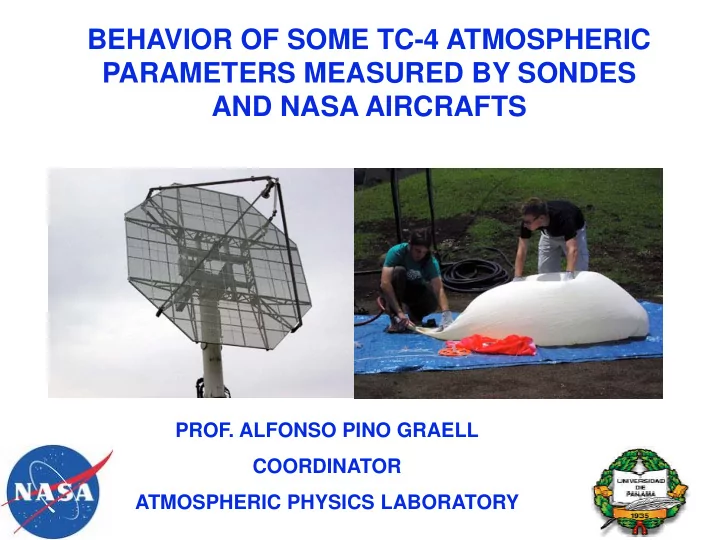

BEHAVIOR OF SOME TC-4 ATMOSPHERIC PARAMETERS MEASURED BY SONDES AND NASA AIRCRAFTS PROF. ALFONSO PINO GRAELL COORDINATOR ATMOSPHERIC PHYSICS LABORATORY
RESULTS AND DISCUSSION RESULTS AND DISCUSSION • In the graphic at left, an inversion layer near 550 mb is relevant. Relative Humidity Profile - Las Tablas Pressure vs Relative Humidity August 4, 2007 • This inversion layer, know n 100 as a tropical inversion near 200 the 0° C level is typical of 300 deep convection. Pressure (mb) 400 500 • The increseasing values of 600 relative humidity 700 corresponding to the 800 inversion layer, could be 900 interpreted as melting and 1000 evaporation of ice crystals in 0 10 20 30 40 50 60 70 80 90 100 Relative Humidity (%) the precipitation systems associated w ith deep convection.
COORDINATED FLIGHTS: DC-8 AND ER-2 August 6, 2007
RESULTS AND DISCUSSION RESULTS AND DISCUSSION • As is show n, the OLR measured above the cirrus layer ( blue curve ) is lesser than the OLR measured below the cirrus layer ( red curve ). • Hence, the cirrus layer has a net absorption of OLR and thus, has a net w arming effect on upper troposphere . Indirectly it has a w arming effect on surface. • Betw een 15 and 16.5 hours ( UTC time ) both aircrafts encountered a thin aged cirrus layer. So, the net w arming effect increases.
RADIATIVE FORCING OF RADIATIVE FORCING OF TROPICAL CIRRUS TROPICAL CIRRUS • Thin Thin cirrus cirrus (optical thickness < 1) are relatively transparent to Short Wave Radiation (albedo ~ 0,25) • Thin tropical Thin tropical cirrus cirrus have a stronger longw ave w arming effect than a shortw ave cooling effect. • Hence, this behavior could cause a net w arming effect on the climate. • Thick cirrus Thick cirrus , are highly reflective to Short Wave Radiation (albedo ~ 0,42) and have a net cooling effect on the climate.
CONCLUSIONS • The relative humidity profiles give reliable information about the presence of tropical deep convection and about the presence of subsequent layers of anvil cirrus generated from convective turrets. • Thin aged anvil cirrus with no convective system below, have a net radiation warming effect at TTL. • The infrared greenhouse effect of thin maritime anvil cirrus outweighs their solar albedo. Thus, the “cloud radiative forcing” (CRF) for this type of clouds is positive. • The effect of these clouds on an additional increment in SST depends on the frequency of convective processes over the ocean, on the extension of cirrus detached from their convective source, on the cloud optical thickness (linked to age of cirrus) and on the ice crystal shapes and size. Larger crystals (>100 μ m) contribute to a net positive Cloud Radiative Forcing.
ACKNOWLEDEGMENT THANKS TO NASA DUE TO THE FACT THAT THE TC-4 PROJECT WILL ALLOW US TO HAVE A BETTER VIEW AND UNDERSTANDING OF THE PHYSICOCHEMICAL PROCESSES AT THE TROPICAL TROPOPAUSE LAYER. ALSO THE TC-4 PROJECT HAS PERMITTED TO GET A BETTER ASSESSMENT OF THE EVOLUTION OF CLIMATE CHANGE AT CENTRAL AMERICA AND PANAMA.
Recommend
More recommend